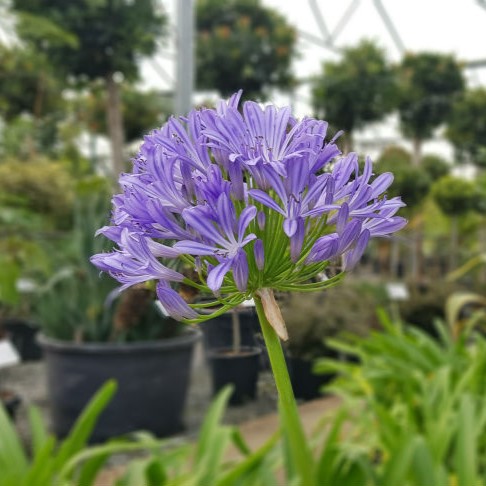Exactly how to Plant and Maintain Agapanthus in Your Garden
Exactly how to Plant and Maintain Agapanthus in Your Garden
Blog Article
Letting Loose the Secret to Successful Agapanthus Farming: Idea for a Flourishing Yard
In the realm of gardening, cultivating agapanthus successfully requires a strategic technique that encompasses various elements of plant care. By comprehending the nuances of agapanthus farming, one can develop an environment where these plants thrive and grow generously.
Planting Agapanthus: Best Practices
When growing Agapanthus, correct soil preparation is important for ensuring successful development and development of these stunning blossoms. Agapanthus, commonly referred to as Lily of the Nile or African lily, flourishes in well-draining soil with a slightly acidic to neutral pH degree - Agapanthus. Before planting, it is important to amend hefty clay dirts with natural matter such as garden compost or peat moss to improve water drainage and offer crucial nutrients for the plants
To plant Agapanthus, select an area that receives full sunlight to partial shade, as this will advertise healthy growth and abundant blooming. Dig an opening two times the diameter of the plant's root ball and place the Agapanthus at the very same depth it was previously growing. Carefully backfill the hole with dirt, weighing down firmly to remove any type of air pockets around the roots.
Water the freshly planted Agapanthus completely and proceed to maintain the dirt evenly moist, especially throughout the plant's active expanding period. Agapanthus. Applying a balanced plant food once a month can even more sustain the plant's growth and blooming. By adhering to these finest methods for planting Agapanthus, you can produce a magnificent display screen of these captivating flowers in your yard
Ideal Soil Issues for Agapanthus
For optimal development and flowering success of Agapanthus plants, making sure the dirt conditions are optimal is important. Agapanthus favors soil that is abundant in nutrients, so incorporating a balanced plant food during the expanding season can promote healthy development and lively flowers.

Watering and Fertilizing Tips
To make certain healthy and balanced growth and dynamic blossoms, appropriate watering and fertilizing techniques are vital for successful Agapanthus growing. Agapanthus plants gain from routine watering, particularly during the expanding period. It is advised to water deeply once a week, ensuring the dirt is moist yet not soaked. During warm weather condition or in pots, even more constant watering might be essential to avoid the soil from drying totally.
When it find more information involves fertilizing Agapanthus, a balanced fertilizer with equal components nitrogen, phosphorus, and potassium can be used in the springtime to advertise healthy development and blooming. Slow-release plant foods are suitable for providing nutrients slowly over a prolonged period. Avoid over-fertilizing, as this can bring about extreme foliage development at the expense of blossoms.
Furthermore, incorporating raw material like garden compost right into the dirt can enhance nutrient degrees and enhance soil framework, aiding in the general health of the Agapanthus plants. By adhering to these watering and fertilizing tips, garden enthusiasts can ensure their Agapanthus plants prosper and produce magnificent displays of blossoms.
Pruning and Deadheading Methods
Proper trimming and deadheading strategies play a crucial function in maintaining the health and wellness and aesthetic appeals of Agapanthus plants, enhancing the vital techniques of watering and fertilizing for effective cultivation. Pruning Agapanthus entails getting rid of invested flower heads, yellowing or dead fallen leaves, and overall shaping of the plant to promote far better growth. Deadheading, the process of getting rid of discolored flowers, not just boosts the plant's appearance however likewise urges further flowering.
When deadheading Agapanthus, it is suggested to basics snip off the flower stem at the base utilizing sharp, tidy shears. This process redirects the plant's energy from seed manufacturing back right into origin and foliage growth, promoting a much healthier and extra robust plant. Regular deadheading can prolong the growing duration of Agapanthus and prevent self-seeding, which can result in congestion.
In regards to trimming, Agapanthus usually take advantage of a light trim after flowering to clean up the plant and urge fresh development. Reducing the invested blossom stems and eliminating any type of damaged or dead foliage helps keep the plant's vitality and general appearance. Nevertheless, it is vital to stay clear of reducing right into the crown of the plant, as this can compromise its health.

Protecting Agapanthus From Vermins and Diseases
Carrying out effective parasite and condition administration strategies is vital to securing the health and wellness and vitality of Agapanthus plants in growing. One usual bug that affects Agapanthus is the Agapanthus borer, a caterpillar that passages into the plant, creating damage to the flowers and leaves.
In addition to pests, Agapanthus are susceptible to diseases such as origin rot and fungal fallen leave areas. By staying watchful and dealing with pest and disease concerns without delay, garden enthusiasts can assist their Agapanthus flourish and thrive.

Verdict
In final thought, effective cultivation of agapanthus needs appropriate growing techniques, ideal soil problems, adequate watering and fertilizing, normal pruning and deadheading, and security from parasites and diseases. By adhering to these suggestions and techniques, gardeners can make sure a prospering garden loaded with gorgeous agapanthus flowers. Agapanthus. Bear in mind to maintain constant treatment and attention to detail to advertise the health and wellness and longevity of these spectacular plants
When growing Agapanthus, correct dirt prep work is crucial for making certain successful growth and advancement of these beautiful flowers.Water the newly planted Agapanthus completely and proceed to maintain the dirt uniformly damp, particularly during the plant's active growing season.For ideal growth and flowering success of Agapanthus plants, guaranteeing the soil conditions are optimal is important. When hair transplanting or growing Agapanthus, ensure the soil is well-prepared to provide the required foundation try this out for the plants to establish themselves successfully. One common parasite that influences Agapanthus is the Agapanthus borer, a caterpillar that passages right into the plant, triggering damage to the flowers and leaves.
Report this page